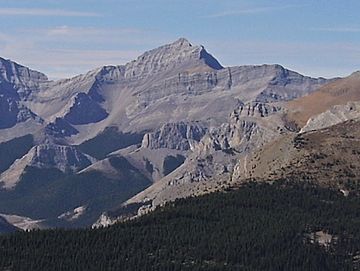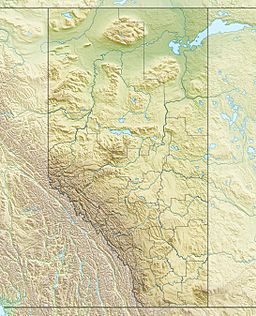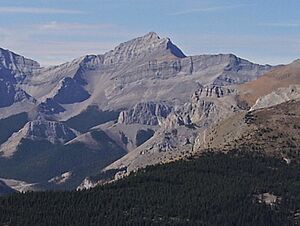Fisher Peak (Alberta) facts for kids
Quick facts for kids Fisher Peak |
|
|---|---|

Fisher Peak seen from Nihahi Ridge
|
|
| Highest point | |
| Elevation | 3,053 m (10,016 ft) |
| Prominence | 904 m (2,966 ft) |
| Parent peak | Mount Evan-Thomas (3098 m) |
| Listing | Mountains of Alberta |
| Geography | |
| Location | Alberta, Canada |
| Parent range | Fisher Range Canadian Rockies |
| Topo map | NTS 82J/14 |
| Geology | |
| Age of rock | Cambrian |
| Type of rock | sedimentary rock |
| Climbing | |
| First ascent | 1950 J.F. Tarrant |
| Easiest route | Difficult, exposed Scramble |
Fisher Peak is a tall mountain summit in the Canadian Rockies of Alberta, Canada. It stands 3,053-metre (10,016-foot) high. This impressive peak is found in the Fisher Range, which is part of Kananaskis Country.
Fisher Peak is the highest point in its own range. The closest mountain that is even taller is Mount Evan-Thomas, about 7.0 km (4.3 mi) away. Water from Fisher Peak flows into two main rivers. Some water goes west into Evan-Thomas Creek, which joins the Kananaskis River. Other water flows east into the Little Elbow River, which then connects to the Elbow River.
Contents
The Story Behind Fisher Peak's Name
How did Fisher Peak get its name? The mountain was named in 1920 after a very important person. His name was John Fisher, 1st Baron Fisher. He was a British admiral, which means he was a high-ranking leader in the navy.
Admiral Fisher was famous for making big changes to the Royal Navy before World War I. He helped make it more modern and powerful. Many people think he was the second most important person in the entire history of the British navy. The name "Fisher Peak" was officially recognized in 1924.
First People to Climb Fisher Peak
The very first time someone successfully climbed to the top of Fisher Peak was in 1950. A person named J.F. Tarrant made this first ascent.
What is Fisher Peak Made Of?
Fisher Peak is mostly made of sedimentary rock. This type of rock forms from layers of sand, mud, and tiny bits of sea creatures that settle at the bottom of ancient seas. Over millions of years, these layers get pressed together and turn into solid rock.
The rocks in Fisher Peak were formed during the Precambrian and Jurassic periods. These are very old times in Earth's history. Later, during a major event called the Laramide orogeny, these rocks were pushed up and over younger rocks. This process helped create the Rocky Mountains we see today.
Weather and Climate at Fisher Peak
Fisher Peak has a subarctic climate. This means it has very cold winters with lots of snow. The summers are usually mild, not too hot.
Temperatures can drop really low, sometimes below −20 °C. With the wind, it can feel even colder, below −30 °C! If you want to climb Fisher Peak, the best time to go is from June through September. The weather is usually much nicer and safer during these months.




